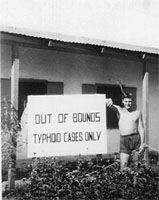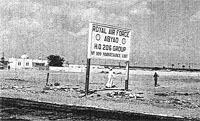
TYPHOID!! – KEEP IT QUIET!
As Remembered By Des Bowen ex: RAF Abu sueir 1949-52
Are there any ex-RAF members who were me with in BMH Fayid in 1950 as the result of the Typhoid outbreak at RAF Abyad? I was unlucky to be detached to Abyad from Abu Suier to help set up an ICAO signals section. Abyad was to become an emergency airfield for airliners on their way to South Africa over-flying the Canal Zone.
On arrival I was warned not to eat in the Airman’s Mess. Not only was the food lousy but the cleanliness left a lot to be desired. So we used to go to the Church Army (or was it the YMCA?) canteen for our meals. It cost us money but as it turned out it was a lot healthier. One day the Church Army canteen was closed for some reason and I was due to go on duty, so reluctantly I had to eat in the Mess. Rumours started to circulate that some people were sick as a result of eating in the Mess.
That next night I nearly floated away on my own sweat and got up the next morning feeling very sick indeed. When I went to report to the sick bay I got lost I was in such a mess. I was soon in the isolation ward at BMH Fayid. I was told that there were as many as 500 of us from Abyad keeping the nursing and medical staff very busy.
The thing that amazes me is that with so many people ill with typhoid, how did the authorities manage to keep it quiet? I have never to this day seen any reports in the media about it. Our folks were told about us and our condition individually but it seems it never got any further than that.
MI6 could learn from that!
PATIENTS IN THE ZONE
As I said I was admitted to BMH Fayid and, although feeling quite poorly, I do remember some comic incidents from the time. For instance when we were being taken from the sick quarters at Abyad to BMH we were taken in a field ambulance no bigger than a Morris van. Six of us were loaded on stretchers and slotted in like files. One couldn’t sit up if you wanted to because above your head there was another stretcher or the roof of the van. The driver no doubt felt he had to get us there in a great hurry, maybe he didn’t want to get the infection, but if we weren’t feeling ill before then we were by the time we got to BMH. Outside the hospital the stretchers were first laid on the ground and I thought this was a sign we had to get up and walk the rest of the way and sat up only to be pushed back down again by the medical orderly.
A sister then came around, I think accompanied by a doctor or medical orderly, and allocated each of us to a ward. I went to Ward 21/22, which was the isolation ward and therefore very comfortable with air conditioning, etc. and was very clean. As we started to recover the army sisters, whom had appeared to be very strict when we first arrived, began to mellow and became very friendly, even the Irish sister in charge.
Later in my stay I remember the doctors wanted to build up our strength before sending us out to the Rehabilitation Centre. They decided the best remedy was a bottle of beer, I think once a day. This was welcomed by the patients, of course. But also they decided we should be fed as much chicken as possible. We had chicken for breakfast, lunch and evening meal! This soon became a standing joke with the boys squatting at the end of their beds, flapping their arms and crowing. I haven’t been able to stomach roast chicken since.
We were then sent to RAF Deversoir for rehab. The only drawback in that was there was no hot water laid on. We were soon showing signs of it on our faces as we tried to shave with cold water. I think my face became so bad I was excused shaving for a while.
TYPHOID OUTBREAK – I WAS THERE
In response to Des Bowen’s article on the typhoid outbreak at Abyad in 1950, I was due for demob at the time. As men were being carted off to BMH, it was decided that the bunch of us who were being held back in case of infection should be posted for a period of quarantine. I think it was Kasfareet that we were sent to. Apparently questions were asked in Parliament as to why we were late for demob.
I certainly remember that about 500 men went down with typhoid, and we heard that of the 36 men in our billet, 18 caught it. I was told that the two lads in the beds on either side of mine had both got it, and that one was so ill they flew his parents out to be with him. How many died (if any) we never heard.
We were held in quarantine for six weeks with fatigues every day, and guard every other night. We really were tired. We heard eventually that the source of the outbreak had been found – apparently they were two short on the local (Egyptian) workers in the cookhouse, so they transferred two from the ‘bog’ wagon. It’s not exactly rocket science to work out that emptying lavatory buckets all day, they may have been typhoid carriers! Maybe MI6 kept it all quiet. – Roy Dolton
Regarding the letter from Des Bowen, I was another one who caught it along with another 300. I could never remember much about it so I sent for my records from the RAF last year which told me that I was admitted to Fayid hospital on the 4th August 1950 and four days later to the BMH Fayid.
They tried out a new drug on us called Chloromycetin which was hailed as a
great success. Previous to this there was no cure. Treatment was good food
and nursing. If I remember correctly only four people died. Years later, when
talking to my doctor about Chloromycetin he was horrified that we took it
internally.
On the 3rd Oct. 1950, I was transferred to a Convalescent Depot at Deversoir which was heaven. We did a little PT in the mornings then swam in the Suez Canal in the afternoon – and the food was good. I was discharged from there on 7th November and went on leave to Port said.
The story was that the cook-house was built over an old native burial ground and it wasn’t the first time typhoid had broken out at Abyad.

– Ted Darrah
No I was not with you at BMH Fayid. However, I was resident at RAF Abyad at
the time of the outbreak. Many RAF personnel went down with the fever, some
went the BMH Fayid, others were isolated at additional facilities set up on
the station. We all underwent a medical test and I was designated to be a carrier
of Typhoid so never suffered the fever.
I partook of most of my meals in the airmen’s mess, quite a variety of food was available at each sitting and apart from sand which drifted in from time to time was quite clean. Using the mess over a period of some 18 months never affected my health or that of my colleagues house in 205 Group tent line.
Many rumours circulated as to the cause of the outbreak none of which were
confirmed. It was alleged that the airmen’s mess had been erected on or
adjacent to a disused cemetery, the Egyptians tend to bury their dead in very
shallow graves, it is possible that contamination could have come from this
source. Many areas of the station were sanitised and the outbreak was quickly
contained. – Ivor Harley ex: 205 Group GHQ

Arriving at RAF Abyad in August 1951, at that time the cookhouse
was new and the story given was that the old one had been burnt down due to
a typhoid epidemic - Dennis Baxter